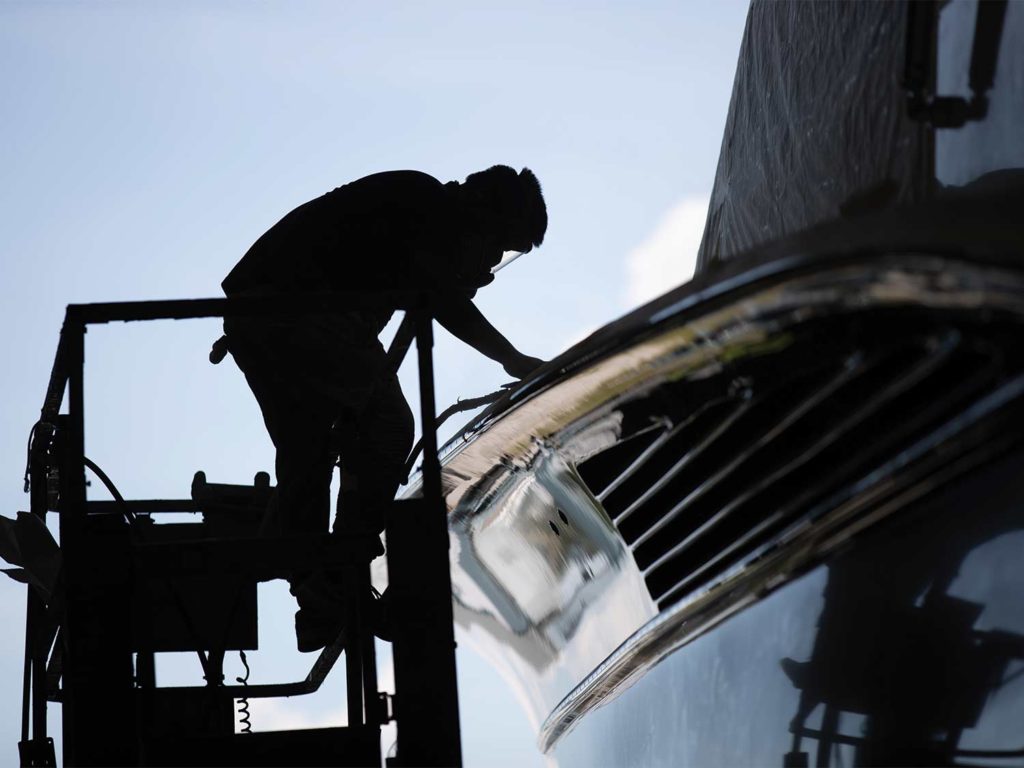
Special delivery: Sign up for the free Marlin email newsletter. Subscribe to Marlin magazine and get a year of highly collectible, keepsake editions – plus access to the digital edition and archives.
Unless you’ve dabbled in crime, you probably don’t spend much time thinking about fingerprints. When you see those signature rings on a lens, screen, or section of varnished teak, you’ll likely wipe them away without a second thought. On the other hand, some fingerprints—those that aren’t so literal—cannot be removed with just a swipe of a rag. They last forever.
Even though you can’t see them, boatbuilders’ fingerprints are etched into every inch of the hull, right alongside the blood, sweat and even the tears of those very same craftsmen. Hundreds of hands are responsible for building a sport-fishing boat from conception to realization. If you do the math, you can easily expect around a thousand years’ worth of experience, talent and artistry behind every new boat. For successful boatbuilding operations such as Gamefisherman, Michael Rybovich & Sons and Jarrett Bay Boatworks, it’s a requirement to have the crew stacked with hardworking professionals with various skillsets. Depth is important on any team, and although each builder boasts a long list of employees with diverse backgrounds and trades, a few stand out as exemplary leaders in the pipeline.
Watch: Take a ride on Wall Hanger, a waterjet-powered beauty from Spencer Yachts.
Jeff Adams, Lead Carpenter, Gamefisherman
Long before Jeff Adams was born, his fate was decided on the cloudy shores of England. There his ancestors built wooden boats, the very vessels that would apparently inspire a long line of familial boatbuilding craftsmen, a skill that would eventually leap the pond to North America.
A South Florida native who’s been building boats professionally for 35 years, Adams really doesn’t know the history of his English relatives. His sister only recently found out after taking a genealogy test that the family bloodlines trace back to English boatbuilders. While boatbuilding may well be in his blood from as long as centuries ago, he learned the trade from someone much closer to home.
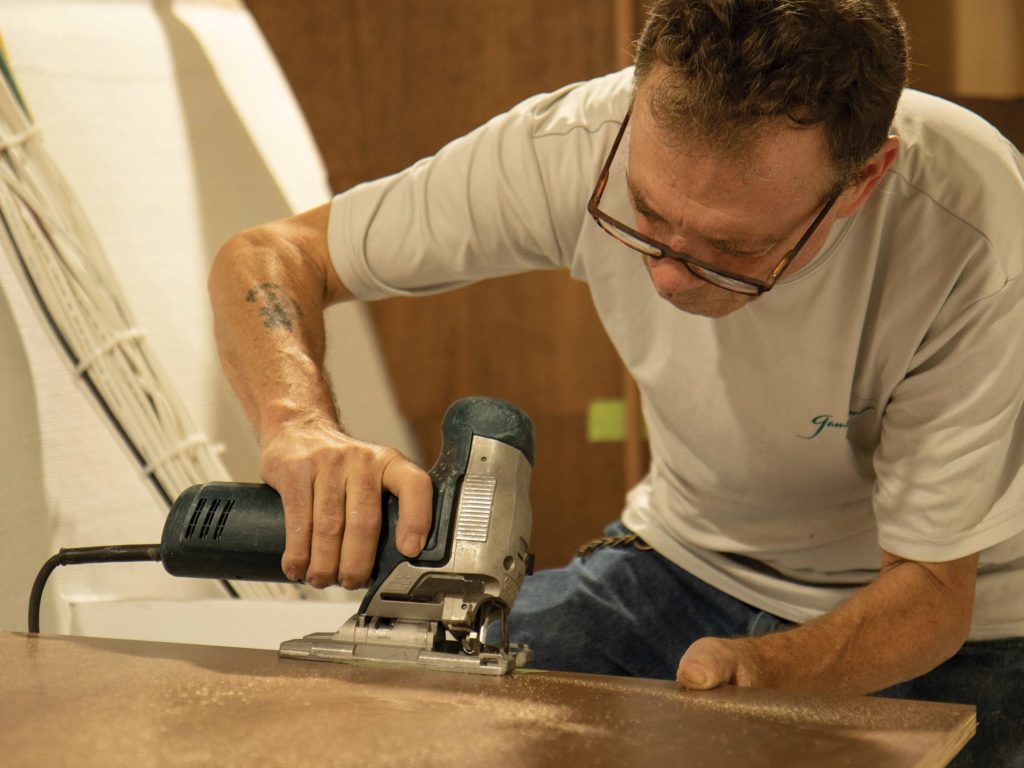
Indeed, boatbuilding is a family tradition. Born in Nova Scotia, Adams’ grandfather Charlie Adams taught Jeff’s uncle Bud how to build boats, who in turn went on to teach him the craft. “My uncle Bud Adams was a very focused and detail-oriented person,” he says. “He was a gentle spirit, and I couldn’t have had a better teacher. When I asked him about what it was like to work with my grandfather, however, he replied, ‘There were some days that you just couldn’t do anything right.’” Adams doesn’t know who taught his grandfather; he never got the chance to ask his uncle about it before he passed away. And even if that bit of history is lost from the records, Adams’ skills are proof alone that his blood runs thick with boatbuilding prowess.
Adams has been working for Gamefisherman, now owned by Release Boatworks, for 12 years. Before that, he worked for his uncle at Adams Boatbuilding, American Custom Yachts and Rybovich. Throughout his career, he’s established himself as a creative problem solver when tackling custom builds. “We count on Jeff to come up with solutions to typical problems that tend to frustrate most boatbuilders,” says Release Boatworks general manager, Jim Turner. “He uses his expert knowledge and skill to keep these projects on course.”
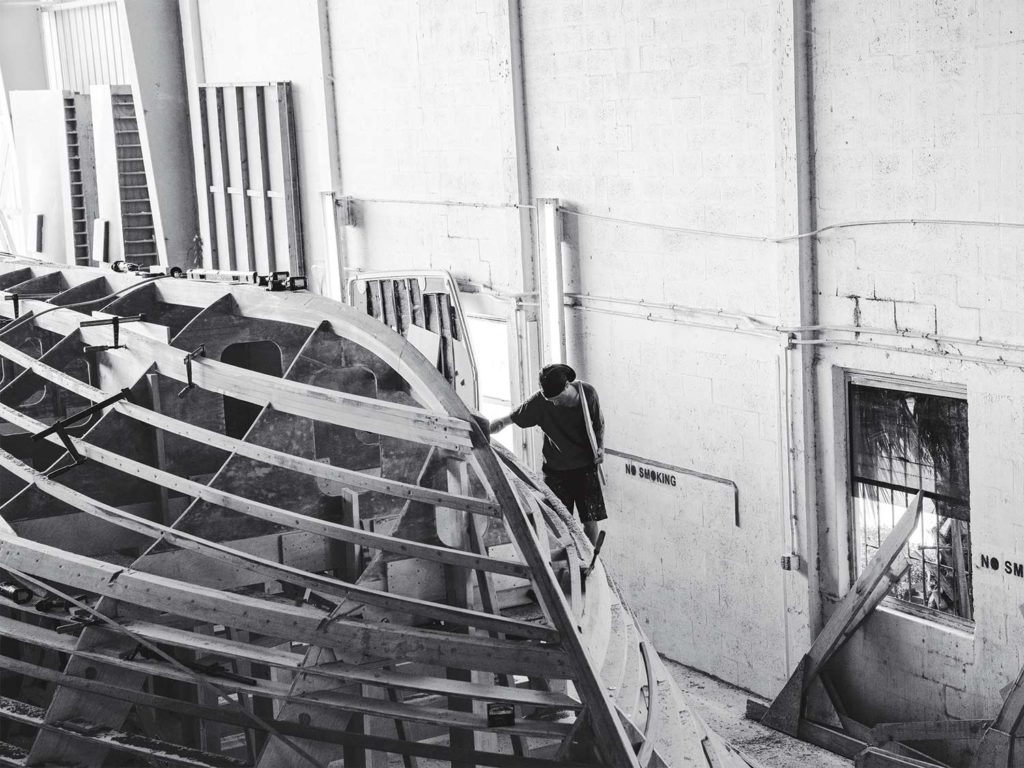
Officially, Adams is a carpenter. That said, he’s had his hands in many aspects of the process. Whether building the hull, perfecting teak covering boards, or cutting out transom doors, he carefully considers every detail of the task, a practice he undoubtedly picked up from his uncle. Attention to detail matters in boatbuilding, especially when working to please the customer footing the bill. “When a customer walks on his boat for the first time, the first things he sees are the covering boards and the joints,” Adams says. “They need to be lined up perfectly and look beautiful. It’s important to wow the customer with the first impression.”
As it turns out, this kind of work, also known as joinery—the process of joining pieces of wood together—is the part of boatbuilding that Adams likes most, and is also one of his greatest strengths. “Some of Jeff’s greatest skills are his historical woodworking capabilities,” Turner explains. “He has the ability to work consistently and patiently to achieve the finest joinery in the industry.”
Adams will always have great love and appreciation for wood boats. The transition to fiberglass has been challenging for the seasoned craftsman, but he understands the perks of such materials. At the end of the day, he’s proud to be working in the boatbuilding industry, and is glad to be able to work alongside his peers to produce these exceptional boats. “There is a great team of builders who really shine here,” Adams says, “and everyone is so nice to work with.”
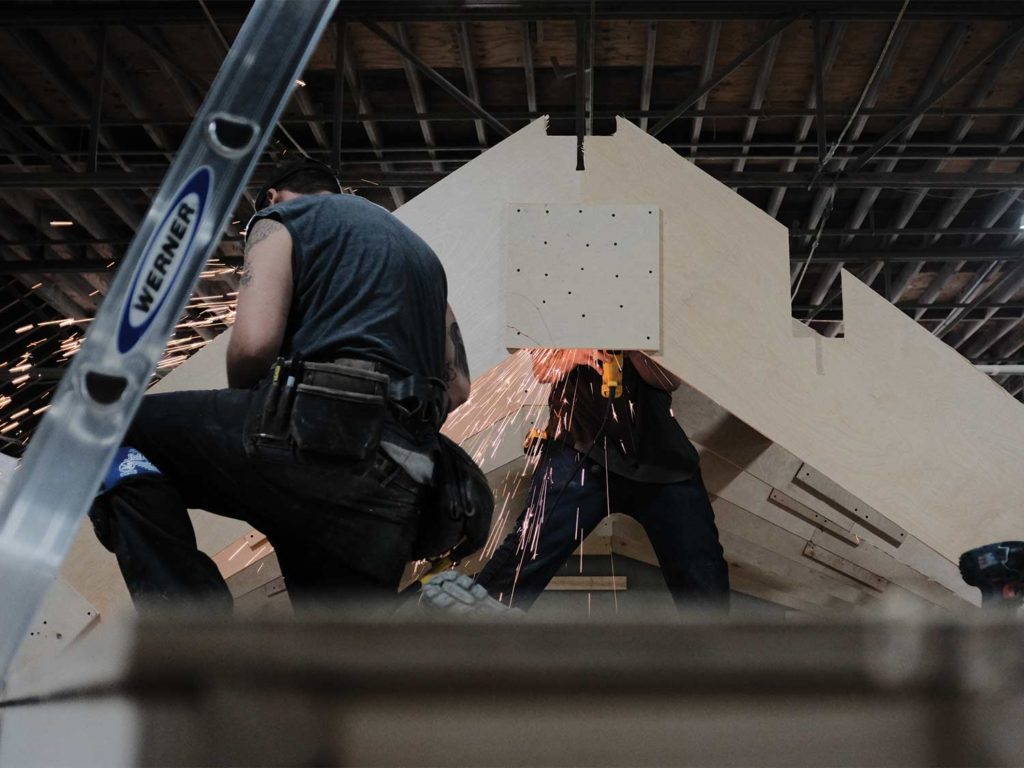
Brian Demerling, Welder/Fabricator, Michael Rybovich & Sons
In 1975, Brian Demerling was a typical teenager who liked fast cars and Bob Seger. He grew up in the stands of the Palm Beach Fairgrounds Speedway in West Palm Beach, Florida, where he first struck an interest in car racing. Because Demerling wanted to drive stock cars, he attended a vocational-education school to learn how to weld. That skill opened up numerous career paths for the young man, and by the time he graduated from high school, Demerling landed a job in a boatyard. Working as a welder and fabricator, he went on to take a position with Rybovich Boat Works in 1979. He has been working there ever since.
Throughout the years, Demerling has worked in various departments with the company, starting with the tower shop. Later, he went on to the outrigger shop, the Rybo Runner brand and, finally, new construction. He’s been through a lot with the company over the years, but he’s remained a steadfast member of the Rybovich team—one of its most reliable and talented craftsmen. “Together, we witnessed the fall from glory of the Rybovich name and the slow re-ascent of that name, through numerous variations, back to one of the industry leaders today,” Michael Rybovich says. “In those 43 years, he’s probably missed a total of five days of work. His skills as a welder, fabricator and mechanic are second to none.”
The team at Rybovich is a welcome mix of tried-and-true veterans and talented young guns. “We’ve got a good bunch of people,” Demerling says. “We build world-class fishing boats, but the yard itself has an old-school vibe, which is really nice.” As one of the veterans, Demerling has worked on 40 or more new builds and countless other boats that visit the yard for service work and refits. After several decades of hard work in the Florida heat, he playfully admits that some things are more difficult for him now than they were when he was a newly minted welder. “For me personally, climbing up and down ladders all day is one of my greatest challenges at work,” he says with a laugh.
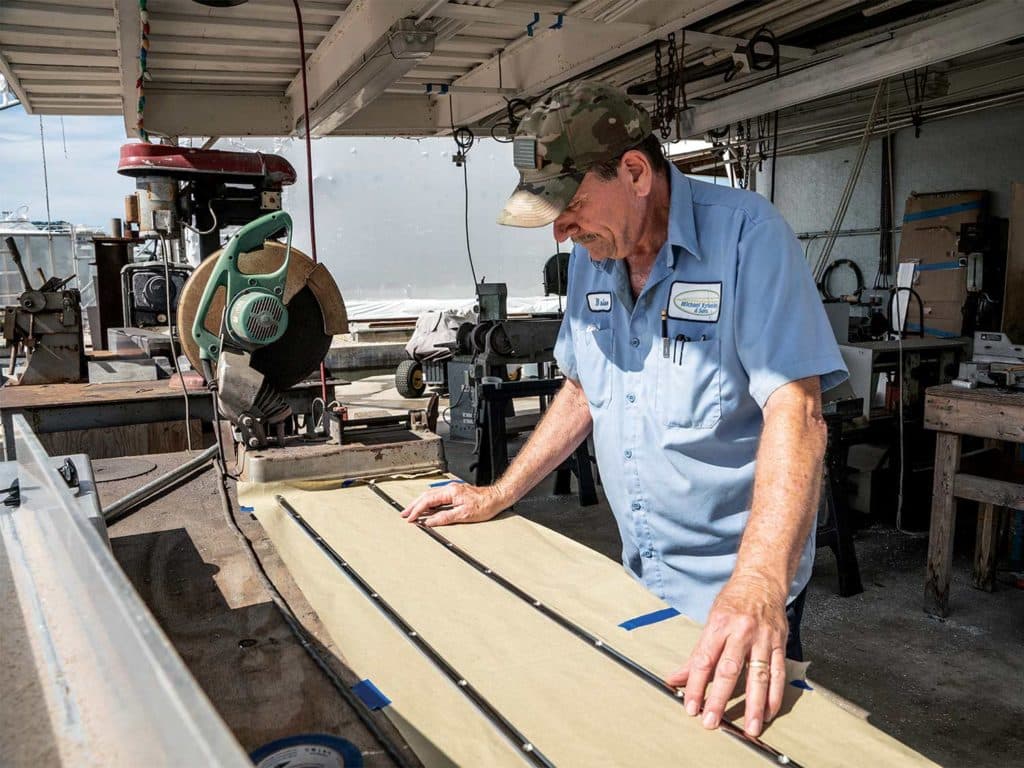
But all jokes aside, Demerling has racked up a lengthy list of accomplishments and skills during his long career with Rybovich, and has seen quite a few of those builds leave the yard for their new home ports. “It’s really gratifying to see an owner so happy and appreciative,” he says. “That’s probably the best part of the whole thing.” And depending upon the scope of the boat, that’s roughly 18 months of construction work heading out of the builders’ hands and into the fishing world, hopefully to do well in what they were designed to do, and there is certainly plenty of emotion tied up in that exchange.
Michael Rybovich recognizes that such successful transitions—ones that leave an owner grinning ear to ear—would be impossible without the hard work of those like Demerling. “Every business owner has a small, loyal, core group of people they rely on for consistent support and quality work,” Rybovich says. “These are the people who fuel the engine of success. Their loyalty and work ethic are relics of better days behind us, when a hard day’s work was a worthy endeavor. When I think of this small, exclusive group of folks at our yard, Brian shakes out at the top of that list. He and a few guys like him make it all worthwhile. Whenever I’m having a tough day, I can always walk over to the welding shop and glance over at Brian as he beautifully fabricates and welds some intricate, necessary component in stainless, bronze, aluminum or steel, and be reassured that there are still great craftsmen in the world who care. I realize how damn lucky we are to work alongside them. Guys like Brian Demerling are the reason we’re still here after all these years.”
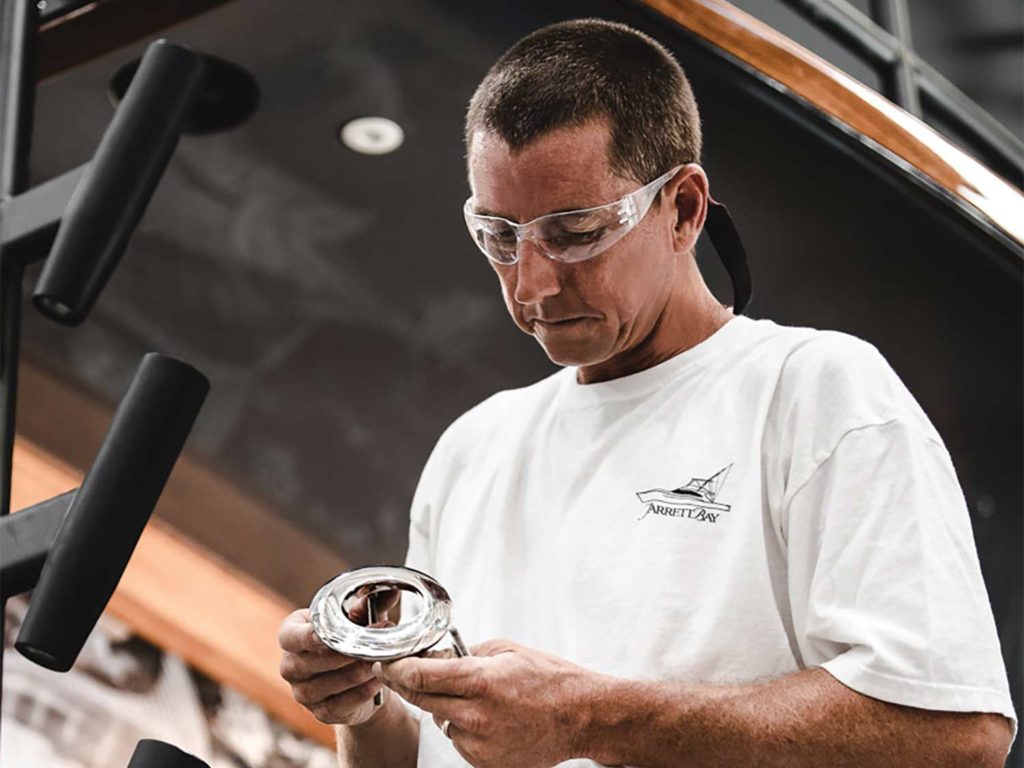
Scott Young, Project Manager, Jarrett Bay Boatworks
When Scott Young first started working at Jarrett Bay Boatworks, his position was supposed to be temporary. He had some background in carpentry, but this was his first job in boatbuilding—a craft he had always been drawn to but had never tried. Young quickly learned that he really enjoyed the work, and the industry. Twenty-two years later, he’s still on the payroll, so it’s safe to say that temporary gig has turned into a legitimate career.
Young grew up on the coast of North Carolina around boats and surfing, so he was well-acquainted with life on the water. In fact, when he stepped into the yard for the first time, he already had some experience working with fiberglass when building surfboards, a skill that would certainly come in handy at Jarrett Bay.
Young started as an entry-level carpenter, a position he describes as “bottom of the barrel,” and worked his way up over the next two decades. In that time, he has excelled in carpentry and metal-working, as well as taking on new management responsibilities. In his current leadership role, Young manages a crew whose work focuses on finishing detailed projects, which requires that they be highly skilled craftsmen. He credits their talents for much of his success as a team leader: “You’re nothing unless you surround yourself with exceptional people,” he says. “My guys make me look good, and they make my life much less stressful.”
“Scott’s recent promotion to project manager has given him an opportunity to shine,” says Tate Lawrence, general manager at Jarrett Bay. “From discussing the options with owners on delivering their dream boats to working out the details with his teammates on how to accomplish the customer’s every wish, he has been a big part of every build starting with Hull No. 29—that’s 39 boats and counting. His dedication and commitment to deliver a quality product is second to none.”
Young can attest to the fact that much in the industry has changed since that first boat. “When I first started, 50 feet was big and 30 knots was fast,” he recalls. “I’ve been around for the evolution of many new standards—from build to tech—such as rounded cabins, sonars and gyros. I don’t think we’ll ever build another boat without those things.” Fortunately, Young enjoys the ever-changing nature of the marine industry. “After a while, you think you understand it,” he says, “but then it throws you another curveball. Everything keeps changing on us, but you have to take the time to figure out where you are going to put this next new system when there isn’t enough room for it.”
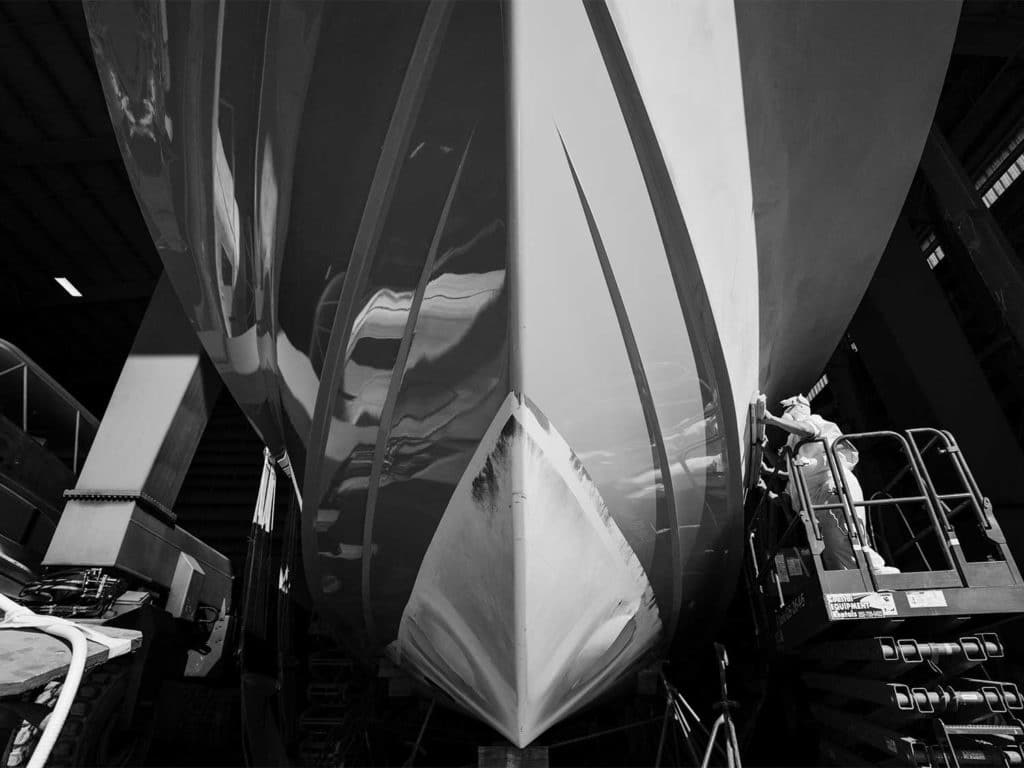
While some might get frustrated by the constant call to adapt, Young seems to flourish under such circumstances. When building a superior vessel such as a Jarrett Bay, you can’t just go to your neighborhood hardware store to buy supplies or purchase a mold. As a result, creative thinking is paramount when tackling a customer’s specialized wants and needs. “One of Scott’s strongest skills is being able to see the outcome of the job before it’s ever started, and finding creative ways to accomplish that. He teaches as he works, he leads through example, and his work ethic is exemplary,” Lawrence says.
Whether building one of Jarrett Bay’s famous boat bars or a cutting-edge, tournament winner with those pretty lines and that Carolina flare, Young has been on the forefront of innovation. “Scott plays a critical role for Jarrett Bay in taking the boats from midway through the build process all the way to delivery,” Lawrence explains. And Young feels relieved when a new build finally changes hands; he looks forward to seeing the boat again come tournament time. “It’s great to hear about the good things, and that we built something that raises fish and wins tournaments,” he says.
Although Young is much too humble to speak to his own skills, those who work with him know how valuable he is to the whole of the operation as an employee, a supervisor and a mentor. “When I think of the men behind the build, I think about words such as dedication, loyalty, commitment, longevity, leadership, role model and mentor, which are all words that describe Scott,” Lawrence says. “He doesn’t stand alone here at Jarrett Bay with these characteristics, but he sure does set the bar high.”
Read Next: Learn more about wake-adapted running gear and how it’s making today’s boats smoother and faster.
When listening to these men talk about boatbuilding, it’s difficult to keep from getting swept up in the romance of the craft. Yes, it’s hard work, often in tough conditions using hazardous materials and tools. But there is a lot of beauty there too. Adams, Demerling and Young are artists whose hands have left those aforementioned, tangible fingerprints on the sport-fishing industry. And while their names might go unrecognized by the masses, those who truly understand the real beauty of the trades will know just how pivotal their work is to fishing communities everywhere.
These beautiful boats are possible thanks to the people who pour themselves into every detail of construction. Each finished boat speaks proudly for herself; the people behind them are imaginative, hardworking, patient, careful and smart. They, along with their colleagues, use their hands—hands that hold decades of blue-collar memory—to build dreams and raise fish. As Young says: “I’m not just a carpenter. I am a boatbuilder.”







